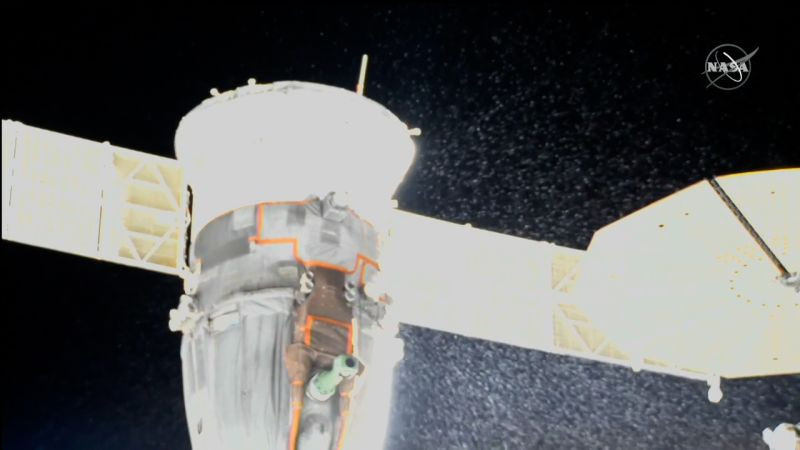
Though oddly beautiful in its own way, it’s a sight no astronaut wants to see: their spacecraft, the only way they have to return to Earth, ejecting countless iridescent droplets of something into space.
When the crew of Apollo 13 saw their craft literally bleeding out on their trip to the Moon it was clear the mission, and ultimately their lives, were in real jeopardy. Luckily the current situation is not nearly as dire, as the leaking Soyuz MS-22 spacecraft docked to the International Space Station doesn’t pose any immediate danger to those aboard the orbiting laboratory. But it’s still an unprecedented situation, and getting its crew home will require engineers on the ground to make some very difficult decisions.
This situation is still developing, and neither NASA nor their Russian counterpart Roscosmos have released much in the way of specifics. But we can make some educated guesses from the video and images we’ve seen of the stricken Soyuz capsule, and from what’s been shown to the public so far, things aren’t looking good.
Running on Empty
On Wednesday the 14th, just as Russian cosmonauts Sergey Prokopyev and Dmitriy Petelin were preparing to begin a scheduled extravehicular activity (EVA) that would have taken them outside of the Station, an alert went off indicating that coolant levels in the docked Soyuz MS-22 capsule were dropping. Upon panning external cameras over to the spacecraft, it was immediately clear this was no false alarm — as liquid could been seen spewing out of the rear of the vehicle.
As illustrated in the diagram above, the Soyuz pumps coolant through a pair of heat exhangers located in the Orbital Module (left) and Descent Module (center), which ultimately makes its way to several external radiators mounted on outside of the Service Module (right). The coolant lines that connect these modules actually run along the outside of the craft’s hull, though they are obscured from view by the thermal blankets that cover most of the vehicle’s exterior.
While the exact cause of the leak is not yet known, the current theory is that a micrometeoroid or other piece of small space debris hit either the radiators or one of the external cooling lines. The hope was that closer examination over the weekend might help determine the cause of the leak, but in any event, the result is the same. With no way to stem the flow, it’s believed that all of the system’s coolant was dumped overboard during the event, leaving the system inoperable.
The system is responsible for not only keeping the inside of the Descent Module at a comfortable temperature for its human occupants, but for cooling the flight computers and other equipment buried deep within the craft. Trying to repair and refill the cooling system while in orbit would be exceptionally difficult, and is almost certainly going to be deemed too risky to even attempt. So the question Russian engineers must now answer is whether or not the Soyuz can safely bring its crew of three back to Earth with its cooling system offline.
Remote Rescue
At the time of this writing, no official announcement has been made, but many space pundits are of the opinion that safest approach is to assume the Soyuz MS-22 is no longer flightworthy. While a system test performed after the leak was discovered showed that the vehicle appeared to be operating normally, and its thrusters were still functional, the possibility of the computer overheating and shutting down during flight presents an unacceptable risk to the crew. The reentry procedure can be performed manually if absolutely necessary, but it’s likely the capsule would land outside of the designated coordinates, complicating recovery operations.

Of course, that assumes the cooling system is the only thing damaged. If the craft was struck with a piece of space debris, there’s no telling what other systems could have been impacted without a thorough examination — something that may difficult to do from an EVA.
If Roscosmos determines that Soyuz MS-22 is no longer fit for purpose, they will likely decide to fly the next Soyuz to the ISS remotely so it can replace the damaged vehicle. If possible, they may even push up the currently scheduled March 2023 launch date.
While exceedingly rare, such a situation isn’t without precedent. In April 1979, when the viability of their Soyuz capsule came into question, the crew of the Soviet Salyut 6 station had to wait on a fresh spacecraft to bring them home. In the end, both the vehicles made it back to Earth safely, but that doesn’t mean it wasn’t worth the additional time and expense to make sure the crew had the best chance of survival.
Not Enough Lifeboats
But there’s a problem with this plan. If it’s determined that the Soyuz MS-22 is no longer safe for human occupants and needs to be replaced, it will mean that for the first time in its history, there won’t be enough spacecraft docked to the International Space Station to bring all of the crew members home in the event of an emergency.
In the unlikely event that the ISS suffers some catastrophic failure before a new Soyuz can be sent up, Sergey Prokopyev and Dmitry Petelin, as well as American astronaut Francisco Rubio, won’t have a safe way off the Station. As a matter of necessity they would likely be instructed to board the semi-functional Soyuz MS-22 and prepare to undock should they need to evacuate, but what happens after that in this nightmare scenario is anyone’s guess. Hopefully, we won’t have to find out.

0 Commentaires